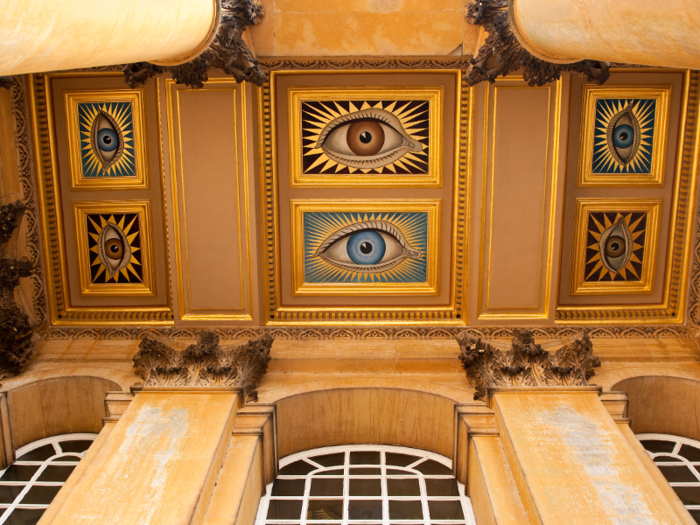
Six unblinking, disembodied eyes bear down on all those who arrive at the principal entrance to the palatial setting of Blenheim Palace, the ancestral home of Sir Winston Churchill. Three eyes are brown, the remaining three a cerulean blue, all of them encased in enigmatic starbursts. It is a peculiar welcome to one of England's largest and most prestigious stately homes, the only secular and non-royal building in the country to be known as a 'palace.'
But Blenheim has always been a place of controversy. The house was built between 1705 and 1722, as a gift from Queen Anne to the 1st Duke of Marlborough for his valiant victory at the Battle of Blenheim in 1704. Planning and development fell to the duke and his wife. They disagreed over who should be entrusted with the design and the job was handed to the English dramatist and sometime architect Sir John Vanbrugh who had worked with Nicholas Hawksmoor on the baroque behemoth of Castle Howard in Yorkshire.
The building is idiosyncratic in all respects. Part mausoleum, part monument, and part domestic family home, it was criticized by the public as a flamboyantly excessive drain on public funds. After completion it became known as an architectural failure that was too severe and grandiose — so much so that Vanbrugh never worked again.

The decoration of the portico dates to 1928 and the patronage of Gladys Deacon, the second wife of the 9th Duke of Marlborough, who commissioned British war artist Colin Gill to paint the eyes of her and her husband in 1928. The duchess allegedly scaled Gill's ladder waving a silk scarf so that he might perfect the exact shade of her famously disarming eyes. Having studied at London's lade School of Fine Art, Gill was dispatched to the Western Fronting France during the First World War, where he employed his artistic training working as a camouflage officer. On his return, he was commissioned to paint a contemporary history painting commemorating the dead for a memorial project known as the Hall of Remembrance, a commemorative building that was never completed. His observations of trench warfare can be seen in the work Heavy Artillery (1919) in the Imperial War Museum, London.
Celebrated for her meteoric beauty and famed for her intellect and wit, the duchess beguiled Europe, capturing the admiration of Marcel Proust, Auguste Rodin (who gifted her a sculpture), Claude Monet, and the Crown Prince of Prussia, among many others. Born in Paris to American parents, she spent most of her early years in France, including an education in a convent to which she was sent after her father murdered her mother's lover.

Unsurprisingly, she acted as muse for a number of modernist artists who captured her in portrait form. They included Italian futurist artist Giovanni Boldini, John Singer Sargent, and the sculptor Jacob Epstein. Soon after her arrival in England, Deacon became the Duke of Marlborough's mistress ensconced at Blenheim, although the pair did not marry until 1921 when his first marriage ended. The second duchess was committed to her pursuit of a perfectly formed Grecian profile, and soon after her marriage she underwent cosmetic surgery to inject paraffin wax into the bridge of her nose. However, the wax became displaced and collected in hard lumps around her chin, disfiguring her famous beauty.

Having said this, the eye as a visual symbol has a significant history and has appeared on churches, temples and even on banknotes. For example, the Eye of Horus was a popular motif in ancient Egyptian mythology and represented good health, protection, and royal power. In Europe in the medieval period the eye symbol was often surrounded by a triangle that symbolized the Holy Trinity of Father, Son and Holy Spirit and represented the omniscient eye of God keeping watch on humanity, and was later taken up by the Freemasons as a reflection of their belief in this all-seeing power who saw and judged everything.
Excerpt from THE ART OF LOOKING UP by Catherine McCormack. Copyright © 2019 by Catherine McCormack. Reprinted by permission of White Lion Publishing.
 Tesla tells some laid-off employees their separation agreements are canceled and new ones are on the way
Tesla tells some laid-off employees their separation agreements are canceled and new ones are on the way Taylor Swift's 'The Tortured Poets Department' is the messiest, horniest, and funniest album she's ever made
Taylor Swift's 'The Tortured Poets Department' is the messiest, horniest, and funniest album she's ever made One of the world's only 5-star airlines seems to be considering asking business-class passengers to bring their own cutlery
One of the world's only 5-star airlines seems to be considering asking business-class passengers to bring their own cutlery The Future of Gaming Technology
The Future of Gaming Technology
 Stock markets stage strong rebound after 4 days of slump; Sensex rallies 599 pts
Stock markets stage strong rebound after 4 days of slump; Sensex rallies 599 pts
 Sustainable Transportation Alternatives
Sustainable Transportation Alternatives

Copyright © 2024. Times Internet Limited. All rights reserved.For reprint rights. Times Syndication Service.